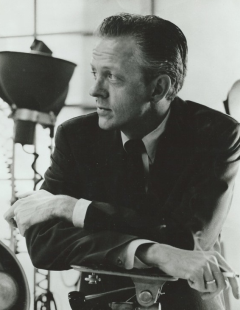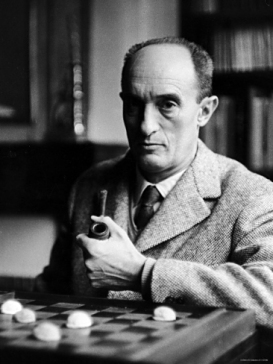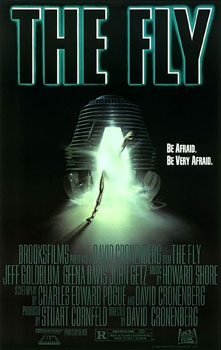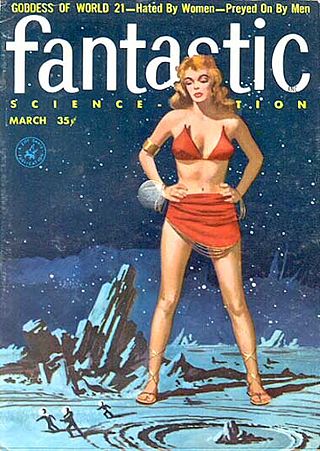
David Paul Cronenberg is a Canadian film director and screenwriter. He is a principal originator of the body horror genre, with his films exploring visceral bodily transformation, infectious diseases, and the intertwining of the psychological, physical, and technological. Cronenberg is best known for exploring these themes through sci-fi horror films such as Shivers (1975), Scanners (1981), Videodrome (1983) and The Fly (1986), though he has also directed dramas, psychological thrillers and gangster films.

Richard Burton Matheson was an American author and screenwriter, primarily in the fantasy, horror, and science fiction genres.

Murray Leinster was a pen name of William Fitzgerald Jenkins, an American writer of genre fiction, particularly of science fiction. He wrote and published more than 1,500 short stories and articles, 14 movie scripts, and hundreds of radio scripts and television plays.

Charles Beaumont was an American author of speculative fiction, including short stories in the horror and science fiction subgenres. He is remembered as a writer of classic Twilight Zone episodes, such as "The Howling Man", "Static", "Miniature", "Printer's Devil", and "Number Twelve Looks Just Like You", but also penned the screenplays for several films, such as 7 Faces of Dr. Lao, The Intruder, and The Masque of the Red Death.

Pierre François Marie Louis Boulle was a French author. He is best known for two works, The Bridge over the River Kwai (1952) and Planet of the Apes (1963), that were both made into award-winning films.

The Fly is a 1986 American science fiction horror film directed and co-written by David Cronenberg. Produced by Brooksfilms and distributed by 20th Century Fox, the film stars Jeff Goldblum, Geena Davis and John Getz. Loosely based on George Langelaan's 1957 short story of the same name and the 1958 film of the same name, The Fly tells of an eccentric scientist who, after one of his experiments goes wrong, slowly turns into a fly-hybrid creature. The score was composed by Howard Shore and the make-up effects were created by Chris Walas, along with makeup artist Stephan Dupuis.

The Fly is a 1958 American science fiction horror film and the first installment in The Fly film series. The film was produced and directed by Kurt Neumann and stars David Hedison, Patricia Owens, Vincent Price, and Herbert Marshall. The screenplay by James Clavell is based on the 1957 short story of the same name by George Langelaan.
John Symonds was an English novelist, biographer, playwright and writer of children's books.
Science fiction opera is a subgenre of science fiction. It refers to operas whose subject-matter fits in the science fiction genre. Like science-fiction literature, science-fiction operas may be set in the future and involve spaceflight or alien invasion. Other science-fiction operas focus on a dystopian view of the future. Like Lorin Maazel's opera 1984, they may be based on a previously written science fiction book.
"The Fly" is a science fiction horror short story by French-British writer George Langelaan. It was published in the June 1957 issue of Playboy magazine. It appeared in SF The Year's Greatest Science-Fiction and Fantasy, Dell First Edition B119, 1958. It was first filmed in 1958, and then again in 1986. An opera of the same name by Howard Shore premiered at the Théâtre du Châtelet, Paris, in 2008. The short story "The Fly" is included in Langelaan's short story collection Out of Time (1964).

Henry Slesar was an American author, playwright, and copywriter. He is famous for his use of irony and twist endings. After reading Slesar's "M Is for the Many" in Ellery Queen's Mystery Magazine, Alfred Hitchcock bought it for adaptation and they began many successful collaborations. Slesar wrote hundreds of scripts for television series and soap operas, leading TV Guide to call him "the writer with the largest audience in America."
John Evan Weston-Davies, known to his friends as Jasper Davies and published as Berkely Mather, was a British writer who wrote fifteen published novels and a book of short stories. He also wrote for radio, television and film.

SF '58: The Year's Greatest Science Fiction and Fantasy is a 1958 anthology of science fiction and fantasy short stories and articles edited by Judith Merril. It was published by Gnome Press in an edition of 4,000 copies of which 1,263 were never bound. It was the third in a series of 12 annual anthologies edited by Merrill. Most of the stories and articles originally appeared in the magazines Science-Fantasy, Playboy, Infinity Science Fiction, Atlantic Monthly, Fantasy and Science Fiction, If, Venture, Mademoiselle, Boys' Life and The New York Times.
The Fly is an opera in two acts by Canadian composer Howard Shore, with a libretto by David Henry Hwang. It was commissioned by the Théâtre du Châtelet in Paris, France, where it premiered on 2 July 2008, and by Edgar Baitzel, then director of the Los Angeles Opera, where the opera was first performed on 7 September 2008. The work was broadcast by Radio France's station France Musique on 2 August 2008.
This article presents an incomplete list of short stories by Robert Sheckley, arranged alphabetically by title.

Gabriele Tinti was an Italian actor who was married to actress and model Laura Gemser.
Arthur Calder-Marshall was an English novelist, essayist, critic, memoirist, and biographer.
Le Collectionneur de cerveaux(Thinking Robots) is a French horror film (1976) based on George Langelaan's novel Les robots pensants starring Claude Jade

The film series of The Fly is a sequence of science fiction-horror films, consisting of an original series started in 1958 and a remake series made in the 1980s. The first film of the series, The Fly, was produced and distributed by 20th Century Fox in 1958 as a colour film. The two following black and white sequels, Return of the Fly and Curse of the Fly, both produced by Associated Producers, were released in 1959 and 1965 respectively. The original film was remade in 1986, The Fly directed by David Cronenberg. The remake film received the Academy Award for Best Makeup in 1987. Its sequel, The Fly II, was released in 1989. All five films within the series were distributed by 20th Century Fox.










